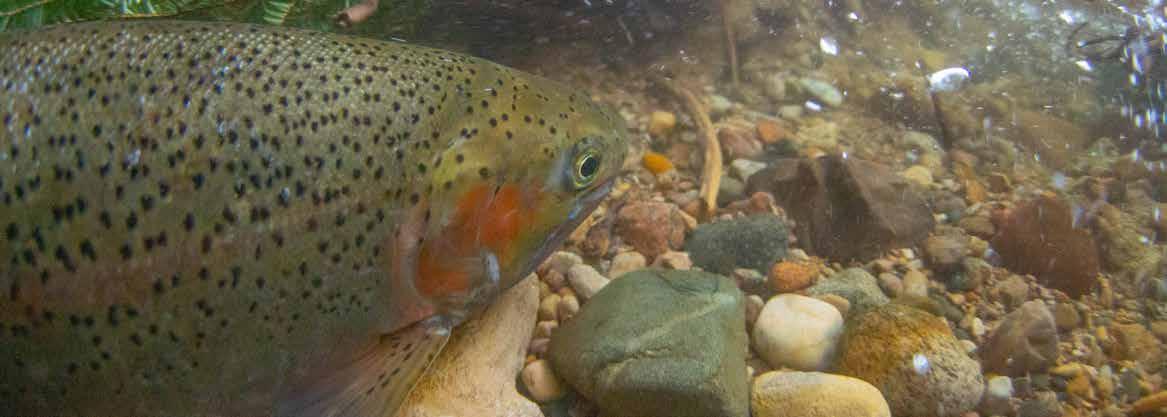Michigan Trout Unlimited
MICHIGAN Trout
A Deeper Look into Beavers and Trout Streams in Michigan
10
by Dr. Bryan Burroughs, Michigan TU Executive Director
Spring 2021
A perennial topic of interest to trout anglers, trout managers, and wildlife managers is the role of beavers and their dams in trout streams. This topic has been around longer than any of us reading this article, yet there routinely remains many subtopics that seem to go unresolved. The purpose of this article is to review what we know and share insights. Regional Context Matters In Michigan, there is much-published research on the role of beavers on rivers. However, most of this was conducted in trout streams in the eastern or western United States. The Midwest and Michigan specifically are fundamentally different from those areas for numerous reasons that are critical in considering how beavers affect trout streams. In the more mountainous east and west, the geology is different, as is the topography and the resulting hydrology of trout streams. In those areas, bedrock and large elevation drops result in trout stream hydrology heavily influenced by runoff. Snowpack melt, much of which does not make it into deep groundwater aquifers, results in high spring flows followed by lower summer base flows. In contrast, Michigan has relatively low elevation drops and deep deposits of sand and glacial till where precipitation feeds into deep aquifers, delivering water to streams in a more stable flow regime. Because of lower stream slopes or gradients and the geology, our streams are dominated by sand and smaller gravels compared to high gradient cobble and boulder streams seen in the eastern and western United States. The effects of beaver dams in the east and west can generally be viewed as dams that create patches of slow water and low gradient habitats within large areas opposite those conditions. Hence, they can serve to create unique habitat diversity. From a hydrology perspective, these small impoundments and created wetlands can absorb and store some of the high peak runoff flows and deliver those floodwaters more slowly, acting as small aquifers of groundwater. This is a summary of many dynamics, but essentially, beaver dams in these contexts create unique and valuable habitats and conditions that are often rare without the beavers. Thus, much of the published research from those areas document positive aspects of beavers to trout streams. In Michigan, most of our trout streams are stable groundwater-fed streams, flowing across low slopes of terrain through relatively finer sediments. Here, beaver dams generally exacerbate already predominant conditions. They can further slow water where it was already flowing slowly. This can lead to additional sedimentation issues where sedimentation is a challenge already. Also, beaver dams can increase water temperature, and although they may help with
flood attenuation, flows may already be relatively stable. The types of habitat diversity we often seek to add or maintain are unique sections of the stream with higher slopes and abundant gravel and cobble. Hence, beaver dams often move us further away from the habitat portfolio we seek to create, even though in other regions of the country, beavers help create sought-after habitat diversity. One interesting benefit of beaver dams widely recognized is that they create a small area of deep water. The deep water behind a beaver dam often serves as a unique holding habitat that fosters larger than average trout, especially brook trout. Almost any ardent brook trout fisherman will take the time to fish a beaver dam pond. However, beaver dams, like all dams, eventually fill in with sediment. After years, deep water becomes shallow warm water with a dark bottom of organic sediments, and the benefit of deep water is lost. Additionally, the warming effect of the beaver dam is a detriment to trout downstream. Thus, a beaver dam has a life cycle that will provide diminishing returns within a few years of being built. Local Site Characteristics Determine Benefits/Detriments of Beaver Dams In general, Michigan beaver dams pose some concerns for trout streams. Even when a beaver pond can make fishing better, those benefits can be very temporary and quickly turn negative. But, for each trout stream with beaver dams that we evaluated, the specific site characteristics mattered in determining how concerned we should be about taking action. Thus, if a trout stream is very cold with an average July mean temperature of 60 degrees, one or more beaver dams that cumulatively warm water temperatures by two degrees would not cause significant impacts. The resulting temperatures would still be ideally cold, and the slight bump in temperatures might improve trout growth rates. In contrast, if a stream is already temperature marginal, with a July mean temperature of 68 degrees, the addition of beaver dams warming the water by two degrees might mean that downstream of the beaver dams may become











